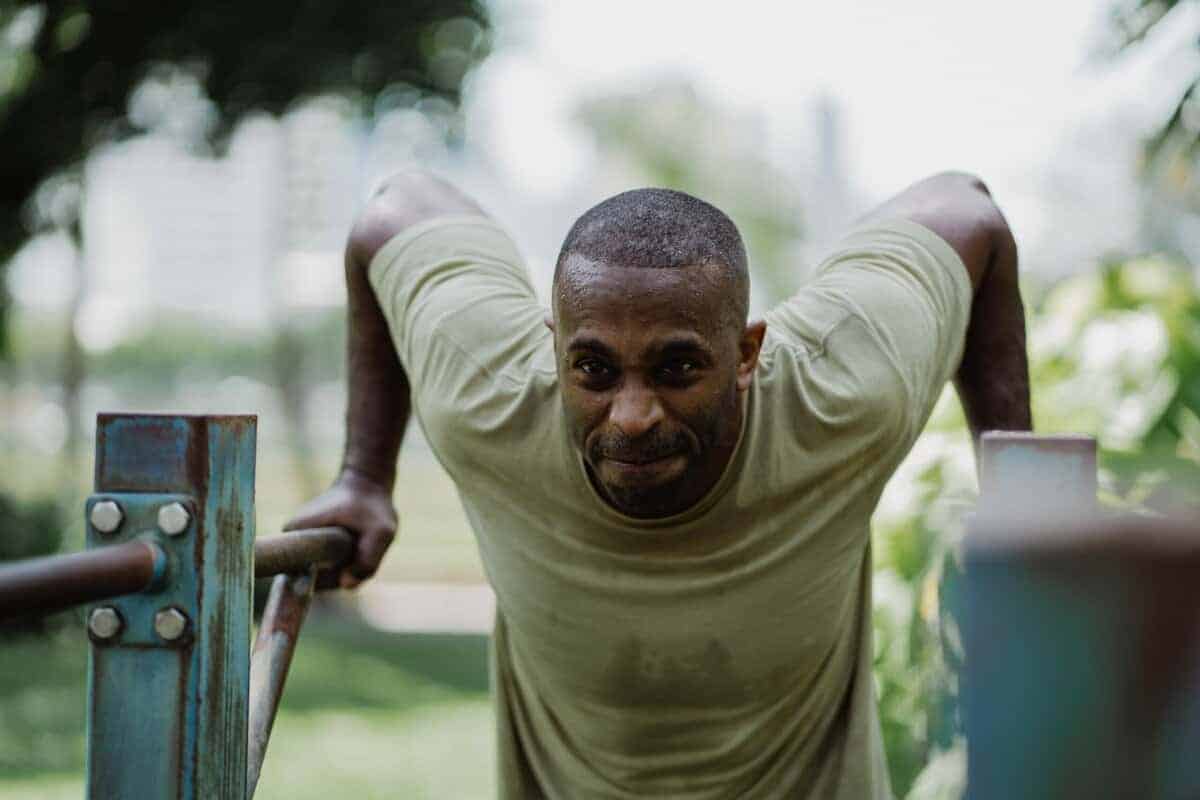Dips on parallel bars is an exercise that can be performed with body weight or with a weight, which would favor the strengthening of the chest muscles (pectorals) shoulders (anterior deltoids) and arms (triceps brachii), which is why this article will analyze everything about this exercise.
What are dips on parallel bars?
It is known that there is a wide variety of exercises that strengthen the chest, shoulders, and arms muscles, such as presses or pushes, both horizontal and vertical. In this regard, dips on parallel bars can contribute significantly to your training plan, but for this exercise, different aspects must be considered for its correct execution.
Firstly, they can be performed on two parallel bars, paying special attention to the flexion and extension of the elbows, which would favor the stimulation of the major and minor pectoral, anterior deltoid, and triceps brachii (1).
On the other hand, the secondary muscles that work are the serratus anterior, coracobrachialis, and subscapularis, and the antagonist muscles include the latissimus dorsi, biceps, posterior deltoid, and trapezius (2).
Actions of the main muscles involved in dips on parallel bars
As mentioned, in dips on parallel bars, the pectoral muscles, anterior deltoid, and triceps brachii (as the main muscles) work together to achieve the execution of the movement.
The pectoralis major occupies the anterior part of the thorax, originating from the clavicle, sternum, and the sheath of the rectus abdominis, inserting into the crest of the greater tubercle of the humerus, and its main functions are; raising the arm forward, it is an adductor muscle and also acts in breathing. Additionally, it has the potential for great stretching capacity (3).
The deltoid muscle is known for its three fascicles, as it provides movement in all directions and great stabilization.
Its three portions insert into the clavicle, acromion, and spine of the scapula, and the deltoid tuberosity of the shoulder is where it inserts.
[article ids=”64703″] It fulfills different functions: the anterior portion raises the arm forward, the posterior portion backward, and the medial portion to the sides. For this, special attention must be paid to the anterior portion, as in dips on parallel bars, its action is also as an internal rotator.
The shoulder muscles also gather and relate to other muscle groups, acting as synergists and antagonists; these are: the supraspinatus, infraspinatus, teres minor and major, and the latissimus dorsi (3).
Thus, in dips on parallel bars, the triceps brachii is responsible for elbow extension, the arm is driven by the long head, in an action of elbow flexion and extension (3).
In other words, it could also be said that the movement occurs over the extension of the forearm over the elbow joint (6).
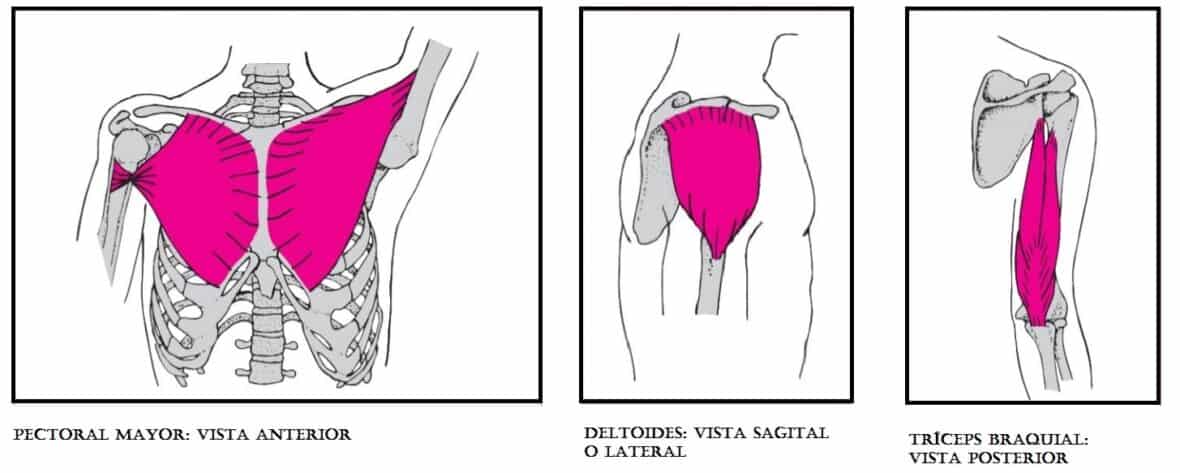
How to do dips on parallel bars?
To perform dips on parallel bars, there are certain points to consider for the correct execution of the exercise, which we will find in order:
- Start with your hands on the parallel bars, legs with knees extended or flexed, and elbows extended.
- You should inhale, flex the elbows when descending in a controlled manner, and extend them to complete the repetition.
- After completing the movement, exhale the air, and continue in the same way.
Delavier, F. (2004), mentions that if the body leans slightly forward, the pectorals take on more work, on the contrary, if you want to focus the work on the triceps, performing it with the trunk aligned will be a better option.
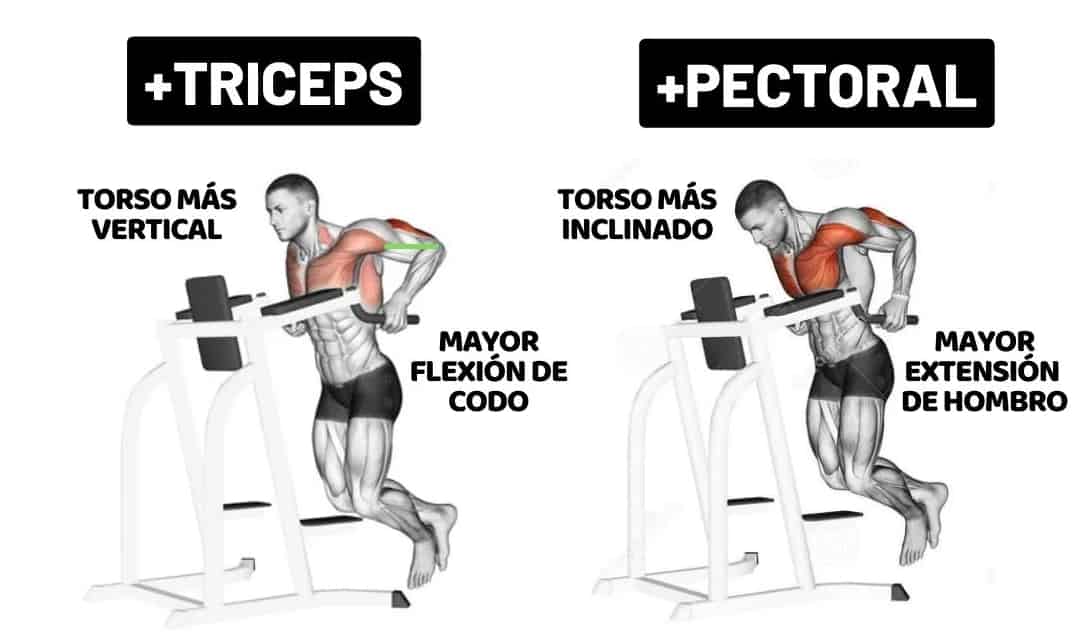
How many dips on parallel bars should I do?
In this way, it is interesting to think that it is not an exercise for beginners or people who are just starting, as there are other more optimal exercise selection options for that age group, with which, it seems that working at a volume of 10 to 20 repetitions would bring good results (4).
That said, it is important that to perform a good technique, uncontrolled and rapid movements, arching, and shrugging the shoulders should be avoided, all in favor of caring for the wrist, elbow, and shoulder joints (5).
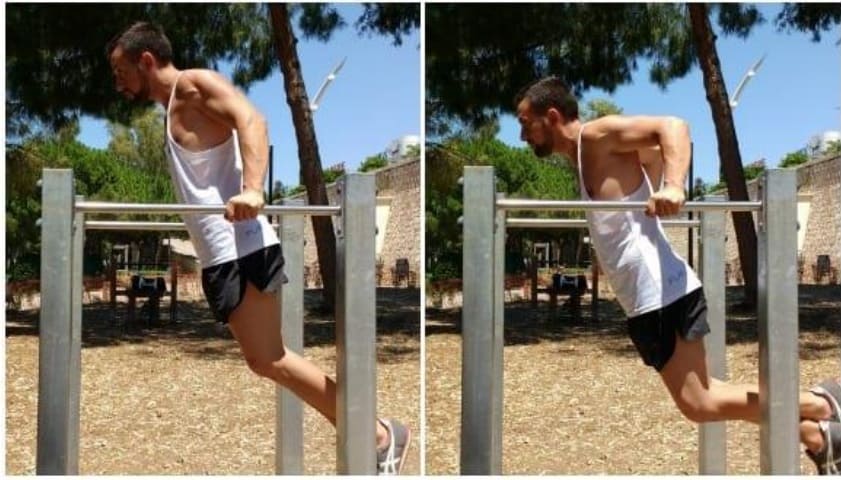
Dips on parallel bars with body weight
This will allow further strengthening of the pectorals (8).
Bodyweight exercises that can be performed for the upper body include: pull-ups, push-ups, dips on parallel bars, rows, which would favor the strengthening of all the muscle groups involved (7).
These types of exercises could be performed outdoors, where if in some park or yard the bars for their practice are found, in the following images we have different types of parallel bars to perform the dips:
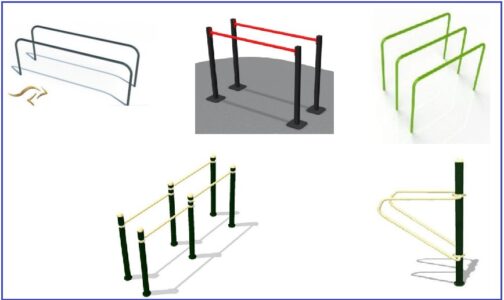
Benefits of dips on parallel bars
Dips on parallel bars offer a series of benefits for those who venture to perform them regularly. Here are some of the key benefits:
- Strengthening of the arms and upper body muscles: Dips on parallel bars are a highly effective exercise for developing strength and size in the triceps, deltoids, pectorals, and back muscles.
- Improvement of shoulder stability: By performing dips on parallel bars, the shoulder stabilizer muscles are strengthened, which helps prevent injuries and improves the function and mobility of this joint.
- Core challenge and stabilization: This exercise requires significant activation of the core muscles to maintain a stable position during the movement. This contributes to improving overall stability and balance.
- Functional training: Dips on parallel bars mimic real-world movements, such as pushing or getting up from the ground. Therefore, they strengthen the muscles needed to carry out daily activities with greater ease.
- Versatility and accessibility: Dips on parallel bars can be performed in a variety of places, whether in a gym, park, or even at home with portable parallel bars. Additionally, they can be adapted to suit different fitness levels.
“Dips on parallel bars are the ultimate challenge for your arms and core. Try them and discover what you’re capable of!” – Anonymous
How to master dips on parallel bars?
Now that you know the benefits of dips on parallel bars, how can you master this technique and take your workouts to the next level? Here are some key tips:
- Start with the proper form: Make sure to maintain correct posture throughout the movement. Keep your elbows close to your body, shoulders down, and back straight. Avoid hunching your shoulders or letting your back arch.
- Gradual progression: If you’re new to dips on parallel bars, start with simpler versions, such as assisted dips with resistance bands or using a chair to support your feet. As you gain strength and confidence, you can perform full dips on parallel bars without additional help.
- Increase the intensity: Once you master the basic dips on parallel bars, you can increase the difficulty in various ways. You can use weights by adding weight to your body with a backpack or a weight belt. You can also vary the angle of the body by leaning forward or backward to focus on different muscles.
- Progressive training: As with any exercise, it’s important to follow a progressive training program. Gradually increase the number of repetitions, sets, or resistance as you become stronger. This will allow you to continue challenging yourself and achieve better results.
- Combine with other exercises: Dips on parallel bars can be incorporated into your training routine along with other complementary exercises. For example, you can combine them with chest push-ups, ring dips, or pull-ups for a complete upper body workout.
Remember that patience and consistency are key to mastering dips on parallel bars. Don’t get discouraged if it seems difficult at first. With practice and perseverance, you’ll be on your way to becoming an expert in this challenging training technique.
|
Characteristics |
Details |
|---|---|
| Type of exercise | Compound, calisthenic |
| Main muscles worked | Triceps, pectorals, deltoids, core muscles |
| Necessary equipment | Parallel bars |
| Difficulty level | Intermediate – Advanced |
| Basic technique | Hold onto the parallel bars, lower the body, and then rise |
| Variants | Triceps dips, chest dips |
| Benefits | Upper body strengthening, improves core stability |
| Precautions | Requires good technique to avoid shoulder and wrist injuries |
Conclusions about dips on parallel bars
Dips on parallel bars are a great exercise for strengthening the pectoral muscles, anterior deltoid, and triceps brachii.
Therefore, using this exercise would be beneficial as a session finisher, where the volume of repetitions could range from 10 to 20 or more depending on the athlete’s level.
Bibliography used
- Staugaard-Jones, J. (2014). Anatomy of movement and exercise. Editorial Paidotribo. Badalona, Spain.
- Esquerdo Morán, O. (2008). Encyclopedia of muscle exercises. Edu Fitness. Madrid, Spain.
- Weinek, J. (2013). Sports Anatomy. 5th edition. Editorial Paidotribo. Barcelona, Spain.
- Frederic, D. (2004). Guide to muscle movement. Anatomical description. Editorial Paidotribo.
- Vella, M. (2007). Anatomy and muscle training for strength and fitness. Editorial Paidotribo. Barcelona, Spain.
- Morera Cos, F and cols. (2011). Terminology of strength exercises with overload. Apunts. Physical Education and Sports, nº. 103, 1st quarter, pp.101-111. ISSN-1577-4015.
- Ramírez Padilla, M. (2022).Design of an outdoor sports station. Universitat Politécnica de Valencia. Spain.
- Geiger Bill. (2015). Chest Workout Technique: Get A Monster Pump With Negative Dips. (Link)
